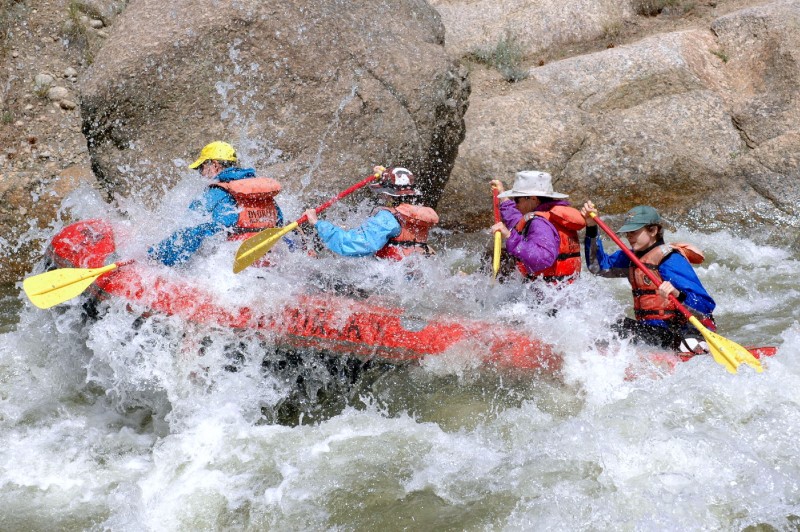
A group white water rafts down the Arkansas River. The sport is a great summer activity for families or more experienced rafters on longer trips.
White water rafting is a great summer outdoor sport for anyone, from the whole family to a group of more experienced rafters looking for a thrill. Depending on the size of the inflatable raft, it’s possible for a group as large as 12 to travel together in one, but splitting people among rafts is also common. Typically, it is recommended to have four to 12 people per raft. Wearing a life jacket, proper clothing, water shoes, and helmet are the first necessary steps to take in learning the sport.
Gaining popularity in the 1970s, white water rafting is made possible by the use of an extremely durable raft made of rubber or vinyl fabrics, housing inflatable air chambers. The size of the raft generally ranges between 10 and 20 feet long with a width of about six to eight feet. However, single-person rafts called “pack-rafts” are another option, though not as common, but come in sizes as small as five feet long and weighing as little as several pounds. The regular-sized rafts come in several different shapes.
If you are new to white water rafting, traveling in a group with a tour guide is the most recommended option, especially when in waters you’re not familiar with. The degree of difficulty in rafting is categorized into six different “grades” or “classes,” which can help you determine what type of waters to begin on based on your ability.
Class 1 is the most basic level and is a great starting point for people who are taking their young children white water rafting as a family event. Class 2 rafting requires the basic knowledge of paddling with the incorporation of some mild obstacles. Class 3 describes waters with small waves that may also require rafters to maneuver their way out of more difficult situations, but no extreme danger is present at this level. Class 4 includes medium-sized waves, more rocks, and sizable drops throughout the river’s course and those attempting these classes should have some intermediate white water experience. Class 5 has large waves, many rocks, and requires much maneuvering. Lastly, class 6 rafting is considered extremely dangerous and near impossible to complete without sustaining injuries, and some class 6 excursions may even have the potential to be fatal to rafters.
When on a basic white water rafting trip, the guide will typically place themselves in the back of the raft and steer. Clear directions are given to the rafters about when and how to paddle, and a beginning lesson on paddling and safety should be given by the guide before even getting in the water. A balance of weight is always the goal when determining what rafters will sit where in the boat. Weight distribution is an advantage when rafts risk running into obstacles, as leaning all people to one area of the raft can help alter direction sometimes more quickly than paddling or back-paddling can.
The two most common ways problems arise in rafting are by obstacles in the water and irresponsible rafters. The first set of problems presented by nature can come in a variety of forms such as fast waters, dams, sharp rocks, waterfalls, or downed trees. Rafters need to be aware of the possible dangers that are apparent in the decision-making process such choosing to drink alcohol while rafting or standing in rocky waters, risking trapping their foot in the river’s bed. These are also common factors that have led to injuries that otherwise could have been prevented. The possibility for injuries while white water rafting at a basic to intermediate level is very low as long as all safety precautions are followed.
In addition, because of increasing concerns for the environment and disruption of natural habitats, many white water rafting locations have limited their tours or only operated during specific times.
Image from Redmarkviolinist on the Wikimedia Commons
 Your Privacy Choices
Your Privacy Choices
 The
The